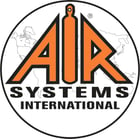-Nov-08-2021-02-14-44-67-PM.png)
Fundamentals of Respiratory Protection
To understand breathing air you MUST first understand the various types of NIOSH approved respirators available to meet respiratory hazards.
All respirators are classified as either Negative Pressure or Positive Pressure Respirators.
Negative Pressure Disposable Mask Respirator
The respirator wearer must inhale through the mask. Approved for dusts, mists, vapors, and fumes. - Not approved for use in IDLH atmospheres (Immediately Dangerous to Life or Health).
Negative Pressure Disposable Cartridge Respirator
This style of respirator has replaceable cartridges or filters and comes in half mask or full face. Powered Air Purifying Respirators (PAPR) are a type of cartridge filtering respirators with a battery-powered blower. They are approved for use where a filter cartridge is approved for the contaminant. Note: Users must be fit tested to assure a proper face seal is achieved. (Not approved for use in IDLH atmospheres).
Positive Pressure (Type-C or CE) Airline Respirator Constant Flow Hood Style
All constant flow respirators supply air continuously to maintain positive pressure inside the face piece or hood. All airline respirators are required by NIOSH as Type-C or Type-CE (approved for sandblasting). Hood Style airline respirators are required by NIOSH to flow 6 - 15 Cfm airflow per person. High-pressure hoods, 25 - 110 psi, would require Grade-D breathing air provided by a Breather Box®. Note: No fit test is required with a hood style respirator. Not approved for use in IDLH atmospheres.
Positive Pressure (Type-C) Airline Respirator - Constant Flow Mask
Positive Pressure respirators are available in half mask or full face and are required by NIOSH to flow 4-15 Cfm per mask, and available in low-pressure style for ambient air pumps, requiring 3 - 15 psi. High-pressure style, 25 - 110 psi, would require Grade-D breathing air provided by a Breather Box®. Constant flow respirators provide higher protection factors than air-purifying negative pressure respirators and are not recommended for use with high-pressure bottled air systems due to their high air consumption. Not approved for use in IDLH atmospheres.
Positive Pressure (Type-C) Airline Respirator Pressure Demand Style
Pressure Demand (PD) respirators supply air “on-demand” and maintain a minimum positive pressure in the face piece at all times. PD respirators are required by NIOSH to flow 4 - 15 cfm to the mask-like a constant flow style respirator. Pressure demand respirators provide a high protection factor and can be used on high-pressure cylinder air or low-pressure filtration systems such as a Breather Box®. All PD respirators operate between 60 - 110 psi and require the use of Grade-D breathing air provided by a Breather Box® or Grade-E cylinder air. PDs with a five-minute escape cylinder can be used in IDLH atmospheres.
Elements of a Type-C/CE Supplied Air System
A Type-C/Ce system consists of the following components:
.png?width=1200&name=Compressed%20Air%20Source%20(1).png)
Sizing a Type-C/CE Airline Filtration System
Sizing of the filtration system, determining what size Breather Box® or panel to order, is based on the airflow (CFM) and pressure requirements (PSI) of the respirators being worn, and the number of workers. Air Consumption (CFM) and Pressure (PSI) ranges for representative types of respirators are listed below:
Pressure Demand: 4 - 15 cfm @ 60 - 120 psi
Constant Flow Half/Full Mask: 4 - 15 cfm @ 4 - 30 psi
Constant Flow Hood (Low Pressure): 6 - 15 cfm @ 3 - 15 psi
Constant Flow Hood (High Pressure): 6 - 15 cfm @ 25 - 110 psi
Vortex Cooling Tube (Option)*: 15 - 25 cfm @ 60 - 110 psi
Once the total number of workers is established and the type of respirator selected, multiply the number of workers by the respirator’s maximum flow rate required per worker to determine total flow requirements:
Example: 4 workers using 4 hood style respirators; 4 x 15 cfm = 60 cfm required
Filtration recommended: Air Systems’ BB50-CO Breather Box®, 4-workers, with CO monitor (maximum flow capacity
of 79 cfm). User must have enough compressor flow (cfm) capacity to supply the above respirators, plus additional air
needs placed on the system, i.e. air tools, spray nozzles, sandblasting, painting, etc.
When ordering a Breather Box®, the customer MUST specify the fittings used on the respirator(s) selected. The Breather
Box® fittings must be the same type as the respirator hose fittings to maintain NIOSH approval on the respirator and
hose assembly.
All Air Systems’ filtration products are designed to flow the maximum amount of air a worker’s respirator could demand. NEVER undersize a filtration system.
Air Filtration Products:
.png?width=247&name=Air%20System%20International%20Breather%20Box%C2%AE%20(1).png)
.png?width=246&name=Air%20System%20International%20Breather%20Box%C2%AE%20(2).png)
.png?width=248&name=Air%20System%20International%20Breather%20Box%C2%AE%20(3).png)
This content was provided in partnership with Air Systems International For the original document please reference: Fundamentals of Respiratory Protection
